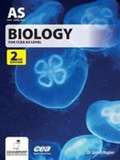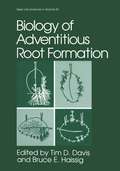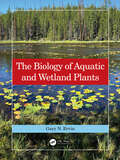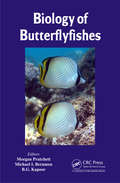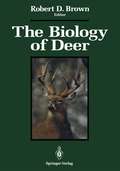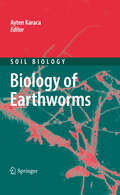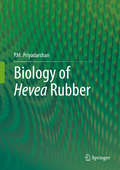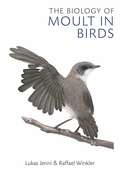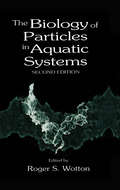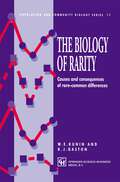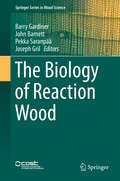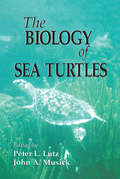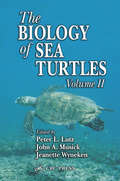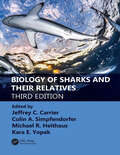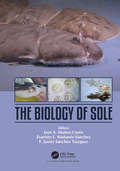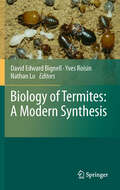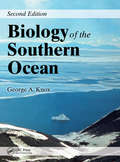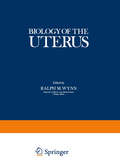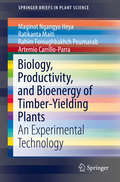- Table View
- List View
Biology for CCEA AS Level (PDF)
by James NapierFully updated for the revised CCEA specification (first teaching September 2016) and endorsed by CCEA. It has been subject to a detailed quality assurance process by an independent Biology expert. It contains new colour-coded practical work sections to address the AS3 paper and provides sample examination questions for each topic. Illustrated in full colour with bright and clear presentation. The author, Dr James Napier, is a well-known Biology author who, prior to his recent retirement, was vice-principal in a Northern Ireland grammar school.
Biology of Adventitious Root Formation (Basic Life Sciences #62)
by Tim D. Davis Bruce E. HaissigCharles E. Hess Department of Environmental Horticulture University of California Davis, CA 95616 Research in the biology of adventitious root formation has a special place in science. It provides an excellent forum in which to pursue fundamental research on the regulation of plant growth and development. At the same time the results of the research have been quickly applied by commercial plant propagators, agronomists, foresters and horticulturists (see the chapter by Kovar and Kuchenbuch, by Ritchie, and by Davies and coworkers in this volume). In an era when there is great interest in speeding technology transfer, the experiences gained in research in adventitious root formation may provide useful examples for other areas of science. Interaction between the fundamental and the applied have been and continue to be facilitated by the establishment, in 1951, of the Plant Propagators' Society, which has evolved into the International Plant Propagators' Society, with active programs in six regions around the world. It is a unique organization which brings together researchers in universities, botanical gardens and arboreta, and commercial plant propagators. In this synergistic environment new knowledge is rapidly transferred and new ideas for fundamental research evolve from the presentations and discussions by experienced plant propagators. In the past 50 years, based on research related to the biology of adventitious root formation, advances in plant propagation have been made on two major fronts.
The Biology of Aquatic and Wetland Plants
by Gary N. ErvinAquatic plants play a critically important role in maintaining ecosystem health. They are natural biological filters in freshwater and estuarine wetlands; they contribute to the reproductive success of many organisms, some of which are harvested for food; they assist in flood control; and they are prominent elements in the aesthetics and recreational use of freshwater and estuarine habitats. Despite this globally recognized importance, wetlands have faced and continue to face threats from the encroachment of human activities. The Biology of Aquatic and Wetland Plants is a thorough and up-to-date textbook devoted to these plants and their interactions with the environment. The focus is on botanical diversity from the perspective of evolutionary relationships, emphasizing the role of evolution in shaping adaptations to the aquatic environment. By incorporating recent findings on the phylogeny of green plants, with special emphasis on the angiosperms, the text is broadly useful for courses in plant biology, physiology, and ecology. Additionally, a chapter on population biology and evolutionary ecology complements the evolutionary backdrop of hydrophyte biology by examining the details of speciation and applications of modern genetic approaches to aquatic plant conservation. Key Features • Synthesizes recent and seminal literature on aquatic and wetland plants • Emphasizes evolutionary history as a factor influencing adaptations to the wetland environment • Provides a global perspective on plant diversity and threats facing wetland ecosystems • Highlights research needs in the field of aquatic and wetland plant biology • Includes 280 figures, with more than 300 color photographs, and 41 tables to provide ease of access to important concepts and information
The Biology of Aquatic and Wetland Plants
by Gary N. ErvinAquatic plants play a critically important role in maintaining ecosystem health. They are natural biological filters in freshwater and estuarine wetlands; they contribute to the reproductive success of many organisms, some of which are harvested for food; they assist in flood control; and they are prominent elements in the aesthetics and recreational use of freshwater and estuarine habitats. Despite this globally recognized importance, wetlands have faced and continue to face threats from the encroachment of human activities. The Biology of Aquatic and Wetland Plants is a thorough and up-to-date textbook devoted to these plants and their interactions with the environment. The focus is on botanical diversity from the perspective of evolutionary relationships, emphasizing the role of evolution in shaping adaptations to the aquatic environment. By incorporating recent findings on the phylogeny of green plants, with special emphasis on the angiosperms, the text is broadly useful for courses in plant biology, physiology, and ecology. Additionally, a chapter on population biology and evolutionary ecology complements the evolutionary backdrop of hydrophyte biology by examining the details of speciation and applications of modern genetic approaches to aquatic plant conservation. Key Features • Synthesizes recent and seminal literature on aquatic and wetland plants • Emphasizes evolutionary history as a factor influencing adaptations to the wetland environment • Provides a global perspective on plant diversity and threats facing wetland ecosystems • Highlights research needs in the field of aquatic and wetland plant biology • Includes 280 figures, with more than 300 color photographs, and 41 tables to provide ease of access to important concepts and information
Biology of Butterflyfishes
by Morgan S. Pratchett Michael L. Berumen B. G. KapoorButterflyfishes (family Chaetodontidae) are a highly conspicuous component of fish fauna on coral reefs throughout the world. In light of their strong dependence on coral, they are often regarded as the epitome of coral reef fishes. This volume examines the ecology and conservation of coral reef butterflyfishes. It provides important insights on th
The Biology of Deer
by Robert D. BrownThe first International Conference on the Biology of Deer Production was held at Dunedin, New Zealand in 1983. That meeting provided, for the first time, a forum for those with interests in either wild deer management or farmed deer production to come together. Scientists, wild deer managers, domestic deer farmers, veterinarians, venison and antler product producers, and others were able to discuss common problems and to share their knowledge and experience. The relationships formed at that meeting, and the information amassed in the resulting Proceedings, sparked new endeavors in cervid research, management, and production. A great deal has taken place in the world of deer biology since 1983. Wild deer populations, although ever increasing in many areas of the world, face new hazards of habitat loss, environmental contamination, and overexploitation. Some species are closer to extinction than ever. Game managers often face political as well as biological challenges. Many more deer are now on farms, leading to greater concerns about disease control and increased needs for husbandry information. Researchers have accumulated considerable new in formation, some of it in areas such as biochemical genetics, not discussed in 1983.
Biology of Earthworms (Soil Biology #24)
by Ayten KaracaEarthworms, which belong to the order Oligochaeta, comprise roughly 3,000 species grouped into five families. Earthworms have been called ‘ecosystem engineers’; much like human engineers, they change the structure of their environments. Earthworms are very versatile and are found in nearly all terrestrial ecosystems. They play an important role in forest and agricultural ecosystems. This Soil Biology volume describes the various facets of earthworms, such as their role in soil improvement, soil structure, and the biocontrol of soil-borne plant fungal diseases. Reviews discuss earthworms’ innate immune system, molecular markers to address various issues of earthworm ecology, earthworm population dynamics, and the influences of organic farming systems and tillage. Further topics include the characteristics of vermicompost, relationships between soil earthworms and enzymes, the role of spermathecae, copulatory behavior, and adjustment of the donated sperm volume.
Biology of Hevea Rubber
by P. M. PriyadarshanIn the second edition of this book, the origin, upkeep and latex harvest from the Hevea rubber tree are dealt with succinctly. New chapters have been included on Propagation Systems and Genetic Resources. The importance of Heterozygosis and Breeding is a new theme for the section on Breeding. A new chapter on Genomics and Molecular Breeding that focuses on the latest advancements on gene mapping, marker assisted selection and stimulation has been added. Lastly, ‘textboxes’ that highlight points and topics of significant interest are included in the new addition.Natural rubber has been an essential commodity not only for the tire industry but also for more than 50,000 products that holds elasticity as an attribute. The prime source of natural rubber worldwide is Hevea brasiliensis. Hevea rubber tree is an excellent example of how a soil-tree-atmosphere system can work in tandem. The retrieval of rubber through ‘injuring’ the tree on alternate days or once in three days or once in seven days, is indeed a unique arrangement followed universally that ensures income to the planter almost throughout the year. Every molecule of rubber is the end result of meticulous biochemical changes. Therefore the biology of Hevea rubber tree itself is a subject that aggregates science and technology for the realization of its industrial utility.
The Biology of Moult in Birds
by Lukas Jenni Raffael WinklerFeathers are amazing structures unique to birds and, for a variety of reasons, they need to be renewed periodically as a whole in a process called moult. During this process, all of the functions of plumage are impaired and most aspects of a bird's life are affected. Every moult determines a bird's appearance anew, and restores plumage efficacy for flight and insulation. Moult profoundly affects physiology and the organization of the annual cycle, and it constrains reproduction and migration. Given these major impacts, which are equal to the other annual challenges of reproduction and migration, it is surprising that research on moult has largely been so neglected a subject. Lukas Jenni and Raffael Winkler have brought together the widely scattered results of studies on the processes and consequences of moult in birds. This book opens with an overview of the functions of plumage, and of feather maintenance and feather wear, and then introduces the two functions of moult: replacement of worn feathers and adjustment of plumage characteristics and appearance. The body of the book then examines feather-growth and the physiology, energetics and control of moult, and how various other physiological processes interact with moult and may compensate for its costs. Significantly, the authors explain how variations in moult and feather quality affect a bird's overall plumage quality, and they highlight the resulting consequences in terms of physical performance, appearance and signalling. Finally, there is a review of all the various solutions that birds have developed to fit moult into the annual cycle.This long-awaited book covers for the first time all aspects of the biology of moult and fills an important gap in the literature, completing our understanding of how the most important annual events in a bird's life fit together into a coherent whole. It draws on a wide range of information – from penguins to small passerines, from raptors to wildfowl – to highlight the variety of the subject and to pinpoint the many gaps in our knowledge along with avenues for fruitful further research.
The Biology of Moult in Birds
by Lukas Jenni Raffael WinklerFeathers are amazing structures unique to birds and, for a variety of reasons, they need to be renewed periodically as a whole in a process called moult. During this process, all of the functions of plumage are impaired and most aspects of a bird's life are affected. Every moult determines a bird's appearance anew, and restores plumage efficacy for flight and insulation. Moult profoundly affects physiology and the organization of the annual cycle, and it constrains reproduction and migration. Given these major impacts, which are equal to the other annual challenges of reproduction and migration, it is surprising that research on moult has largely been so neglected a subject. Lukas Jenni and Raffael Winkler have brought together the widely scattered results of studies on the processes and consequences of moult in birds. This book opens with an overview of the functions of plumage, and of feather maintenance and feather wear, and then introduces the two functions of moult: replacement of worn feathers and adjustment of plumage characteristics and appearance. The body of the book then examines feather-growth and the physiology, energetics and control of moult, and how various other physiological processes interact with moult and may compensate for its costs. Significantly, the authors explain how variations in moult and feather quality affect a bird's overall plumage quality, and they highlight the resulting consequences in terms of physical performance, appearance and signalling. Finally, there is a review of all the various solutions that birds have developed to fit moult into the annual cycle.This long-awaited book covers for the first time all aspects of the biology of moult and fills an important gap in the literature, completing our understanding of how the most important annual events in a bird's life fit together into a coherent whole. It draws on a wide range of information – from penguins to small passerines, from raptors to wildfowl – to highlight the variety of the subject and to pinpoint the many gaps in our knowledge along with avenues for fruitful further research.
The Biology of Particles in Aquatic Systems, Second Edition
by Roger S. WottonThe Biology of Particles in Aquatic Systems, Second Edition presents the latest information on particulate and dissolved matter found in aquatic habitats ranging from small streams to oceans. Only by studying this matter can we gain an understanding of the functioning of aquatic ecosystems and thus be able to predict changes that may occur as these systems become stressed. Updated and extensively revised, this new edition covers such topics as classification of particulate and dissolved matter, origin and formation of particles aquatic systems, factors affecting particle aggregation, methods for capturing particles by benthic and planktonic animals, and the use of particulate and dissolved organic matter as food.
The Biology of Particles in Aquatic Systems, Second Edition
by Roger S. WottonThe Biology of Particles in Aquatic Systems, Second Edition presents the latest information on particulate and dissolved matter found in aquatic habitats ranging from small streams to oceans. Only by studying this matter can we gain an understanding of the functioning of aquatic ecosystems and thus be able to predict changes that may occur as these systems become stressed. Updated and extensively revised, this new edition covers such topics as classification of particulate and dissolved matter, origin and formation of particles aquatic systems, factors affecting particle aggregation, methods for capturing particles by benthic and planktonic animals, and the use of particulate and dissolved organic matter as food.
The Biology of Rarity: Causes and consequences of rare—common differences (Population and Community Biology Series #17)
by Kevin J. Gaston William E. KuninThis book began life as a review article. That article spawned a symposium which was, in turn, greatly expanded to form the present volume. As the project moved through these developmental stages (hopefully, towards attainment of its full maturity), a number of people have provided invaluable assistance to us, and we would like to take this opportunity to thank them. Gordon Orians must certainly take a high place in that list. He has been both a friend and mentor to W.E.K., and many of the topics explored in this book have emerged from the resultant dialogue. His thought processes, ideas and perhaps even some of his turns of phrase emerge throughout much ofthe book. Gordon also played a pivotal role in inviting in motion, and so he has served as a catalyst the article that set this project to the book as well as one of its reagents. While he has not served as an editor of this book, he is one of its authors in more than just the literal sense.
The Biology of Reaction Wood (Springer Series in Wood Science #Vol. 31)
by Barry Gardiner John Barnett Pekka Saranpää Joseph GrilThe book is a fundamental reference source on reaction wood for wood scientists and technologists, plant biologists, silviculturists, forest ecologists, and anyone involved in the growing of trees and the processing of wood. It brings together our current understanding of all aspects of reaction wood, and is the first book to discuss both compression wood and tension wood.Trees produce reaction wood to maintain the vertical orientation of their stems and the optimum angle of each branch. They achieve this by laying down fibre cell walls in which differences in physical and chemical structure from those of normal fibres are expressed as differential stresses across the stem or branch. This process, while of obvious value for the survival of the tree, causes serious problems for the utilisation of timber. Timber derived from trees containing significant amounts of reaction wood is subject to dimensional instability on drying, causing twisting, bending and splitting. It is also difficult to work as timber, and for the pulp and paper industry the cost of removing the increased amount of lignin in compression wood is substantial. This has both practical and economic consequences for industry.Understanding the factors controlling reaction wood formation and its effect on wood structure is therefore fundamental to our understanding of the adaptation of trees to their environment and to the sustainable use of wood.The topics covered include:-Morphology, anatomy and ultrastructure of reaction wood-Cell-wall polymers in reaction wood and their biosynthesis-Changes in tree proteomes during reaction wood formation-The biomechanical action and biological functions of reaction wood- Physical and mechanical properties of reaction wood from the scale of cell walls to planks-The detection and characterisation of compression wood-Effects of reaction wood on the performance of wood and wood-based products- Commercial implications of reaction wood and the influence of forest management on its formation
The Biology of Sea Turtles, Volume I (CRC Marine Science #12)
by Peter L. Lutz John A. MusickSea turtles have existed for millions of years, making them fascinating subjects of study. In the last 20 years, the science of sea turtle biology has expanded at an exponential rate, leading to major advances in many areas. This book synthesizes the results of these advances and focuses on how these endangered marine reptiles operate in, adapt to, and are dependent upon particular features of their marine environment. New technology in data gathering, such as DNA analyses, remote sensing, and physiological monitoring techniques, has led to a much greater understanding of the biology of the sea turtle at all stages of their life history.
The Biology of Sea Turtles, Volume I (CRC Marine Science #12)
by Peter L. Lutz John A. MusickSea turtles have existed for millions of years, making them fascinating subjects of study. In the last 20 years, the science of sea turtle biology has expanded at an exponential rate, leading to major advances in many areas. This book synthesizes the results of these advances and focuses on how these endangered marine reptiles operate in, adapt to, and are dependent upon particular features of their marine environment. New technology in data gathering, such as DNA analyses, remote sensing, and physiological monitoring techniques, has led to a much greater understanding of the biology of the sea turtle at all stages of their life history.
The Biology of Sea Turtles, Volume II
by Peter L. Lutz John A. Musick Jeanette WynekenThe success of the first volume of The Biology of Sea Turtles revealed a need for broad but comprehensive reviews of major recent advances in sea turtle biology. Biology of Sea Turtles, Volume II emphasizes practical aspects of biology that relate to sea turtle management and to changes in marine and coastal ecosystems. These topics i
Biology of Sharks and Their Relatives (CRC Marine Biology Series)
by Jeffrey C. Carrier Colin A. Simpfendorfer Michael R. Heithaus Kara E. YopakBiology of Sharks and Their Relatives is an award-winning and groundbreaking exploration of the fundamental elements of the taxonomy, systematics, physiology, and ecology of sharks, skates, rays, and chimera. This edition presents current research as well as traditional models, to provide future researchers with solid historical foundations in shark research as well as presenting current trends from which to develop new frontiers in their own work. Traditional areas of study such as age and growth, reproduction, taxonomy and systematics, sensory biology, and ecology are updated with contemporary research that incorporates emerging techniques including molecular genetics, exploratory techniques in artificial insemination, and the rapidly expanding fields of satellite tracking, remote sensing, accelerometry, and imaging. With two new editors and 90 contributors from the US, UK, South Africa, Portugal, France, Canada, New Zealand, Australia, India, Palau, United Arab Emirates, Micronesia, Sweden, Argentina, Indonesia, Cameroon, and the Netherlands, this third edition is the most global and comprehensive yet. It adds six new chapters representing extensive studies of health, stress, disease and pathology, and social structure, and continues to explore elasmobranch ecological roles and interactions with their habitats. The book concludes with a comprehensive review of conservation policies, management, and strategies, as well as consideration of the potential effects of impending climate change. Presenting cohesive and integrated coverage of key topics and discussing technological advances used in modern shark research, this revised edition offers a well-rounded picture for students and researchers.
Biology of Sharks and Their Relatives (CRC Marine Biology Series)
by Jeffrey C. Carrier Colin A. Simpfendorfer Michael R. Heithaus Kara E. YopakBiology of Sharks and Their Relatives is an award-winning and groundbreaking exploration of the fundamental elements of the taxonomy, systematics, physiology, and ecology of sharks, skates, rays, and chimera. This edition presents current research as well as traditional models, to provide future researchers with solid historical foundations in shark research as well as presenting current trends from which to develop new frontiers in their own work. Traditional areas of study such as age and growth, reproduction, taxonomy and systematics, sensory biology, and ecology are updated with contemporary research that incorporates emerging techniques including molecular genetics, exploratory techniques in artificial insemination, and the rapidly expanding fields of satellite tracking, remote sensing, accelerometry, and imaging. With two new editors and 90 contributors from the US, UK, South Africa, Portugal, France, Canada, New Zealand, Australia, India, Palau, United Arab Emirates, Micronesia, Sweden, Argentina, Indonesia, Cameroon, and the Netherlands, this third edition is the most global and comprehensive yet. It adds six new chapters representing extensive studies of health, stress, disease and pathology, and social structure, and continues to explore elasmobranch ecological roles and interactions with their habitats. The book concludes with a comprehensive review of conservation policies, management, and strategies, as well as consideration of the potential effects of impending climate change. Presenting cohesive and integrated coverage of key topics and discussing technological advances used in modern shark research, this revised edition offers a well-rounded picture for students and researchers.
The Biology of Sole
by José A. Munoz-Cueto Evaristo Mañanós-Sánchez F. Javier Sánchez-VázquezThis book reviews up-to-date knowledge on the biology of sole (Solea senegalensis and S. solea). These flatfish species are increasingly important in Europe both from the ecological and production point of view. This book is divided into two sections: A. general fisheries, aquaculture and engineering overviews; B. physiological, developmental, rhythmic, welfare and genetic aspects which will be of immense interest for the aquaculture industry. Experts, from both academia and research institutes, provide their expertise on sole biology.
The Biology of Sole
by Jose A. Muñoz-Cueto F. Javier Sánchez-Vázquez F. Javier Sanchez Vazquez Evaristo Mañanós-SánchezThis book reviews up-to-date knowledge on the biology of sole (Solea senegalensis and S. solea). These flatfish species are increasingly important in Europe both from the ecological and production point of view. This book is divided into two sections: A. general fisheries, aquaculture and engineering overviews; B. physiological, developmental, rhythmic, welfare and genetic aspects which will be of immense interest for the aquaculture industry. Experts, from both academia and research institutes, provide their expertise on sole biology.
Biology of Termites: a Modern Synthesis
by David Edward Edward Bignell, Yves Roisin and Nathan LoBiology of Termites, a Modern Synthesis brings together the major advances in termite biology, phylogenetics, social evolution and biogeography. In this new volume, David Bignell, Yves Roisin and Nathan Lo have brought together leading experts on termite taxonomy, behaviour, genetics, caste differentiation, physiology, microbiology, mound architecture, biogeography and control. Very strong evolutionary and developmental themes run through the individual chapters, fed by new data streams from molecular sequencing, and for the first time it is possible to compare the social organisation of termites with that of the social Hymenoptera, focusing on caste determination, population genetics, cooperative behaviour, nest hygiene and symbioses with microorganisms. New chapters have been added on termite pheromones, termites as pests of agriculture and on destructive invasive species.
Biology of the Southern Ocean
by George A. KnoxFirst published in 1993, The Biology of the Southern Ocean has been referred to as international research at its best and an invaluable reference. Drawing on the considerable volume of information published in the last ten years, this second edition retains the format that made the first edition a popular bestseller, while updating the information
Biology of the Uterus
by Ralph WynnIn the decade following the publication of the first edition of Cellular Biology of the Uterus, advances in this field have been so rapid as to require not merely a revision of the earlier text but an essentially new volume. Even the title of the book has been changed, to Biology of the Uterus, to reflect the incorporation of more material based on classical anatomy and physiology. This histological and embryological information provides a necessary, though often lacking, background for the protein chemist and molecular biologist, and a bridge between biochemistry and biophysics, on the one hand, and clinical medicine, on the other. Thus, major practical problems in human reproduction, such as the mode of action of contraceptive agents and the cause of the initiation of labor, may be approached on a firm scientific footing. This text deals primarily with the biology of the uterus itself (comparative and human) rather than with placentation or pregnancy, and as such is a synthesis of data derived from many techniques, conventional and modern. Inasmuch as it is clearly beyond the competence of anyone scientist to prepare such a text on the basis of personal knowledge and experience, the aid of distinguished biologists from this country and abroad was enlisted. All of these authors, acknowledged experts in their respective fields, agreed to extensive revision of their chapters or preparation of entirely new contributions.
Biology, Productivity and Bioenergy of Timber-Yielding Plants: An Experimental Technology (SpringerBriefs in Plant Science)
by Maginot Ngangyo Heya Ratikanta Maiti Rahim Foroughbakhch Pournavab Artemio Carrillo-ParraFace to the current global energy crisis, there is an urgent necessity of searching for alternatives to fossil fuels, and this book shows how timber is a promising resource for sustainable energy production. Northeast Mexico represents an important forest resource to satisfy the needs of the population in these areas. In order to harness these forest resources, technology for exploring these valuable resources must be developed. These technologies (with special reference to biology and wood technologies) are available in scattered form in a few books but there is no central, comprehensive source for practical forest scientists for adopting efficient forest management, practice, and exploration. This book deals with the characterization of the vegetation, morphology, phenological development, biomass production (leaf, litter, wood), and bioenergy of some timber-yielding species of Northeast Mexico, which will serve as a guide to study timber-yielding plants in the native vegetation of Tamaulipan thornscrub and experimental plantations. This includes morphology, vegetation cover, biomass production in terms of volume leaf biomass, litter, and volume of fire wood and timber. Special emphasis is given to the estimation of bioenergy products and chemical composition (Ph, extractable lignin, and inorganic elements). Large variations exist in vegetation cover, morphology, phenological development, biomass production of leaf and litter, volume of wood and various variable of bioenergy products among the selected species. The maximum production was found in summer and the volume of the harvestable timber was obtained in experimental plantations. This book, therefore, will serve as a practical handbook to characterize timber-yielding plants, which will help to efficiently manage forestry resources.
